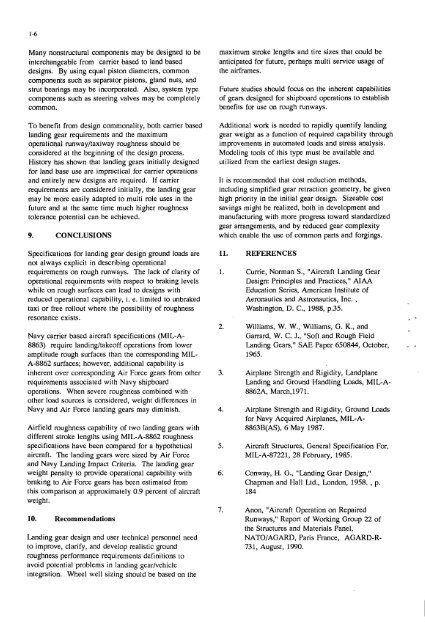AGARD R-800 - FTP Directory Listing - Nato
AGARD R-800 - FTP Directory Listing - Nato
AGARD R-800 - FTP Directory Listing - Nato
Create successful ePaper yourself
Turn your PDF publications into a flip-book with our unique Google optimized e-Paper software.
1-6<br />
Many nonstructural components may be designed to be<br />
interchangeable from carrier based to land based<br />
designs. By using equal piston diameters, common<br />
components such as separator pistons, gland nuts, and<br />
strut bearings may be incorporated. Also, system type<br />
components such as steering valves may be completely<br />
com mon .<br />
To benefit from design commonality, both carrier based<br />
landing gear requirements and the maximum<br />
operational runway/taxiway roughness should be<br />
considered at the beginning of the design process.<br />
History has shown that landing gears initially designed<br />
for land base use are impractical for carrier operations<br />
and entirely new designs are required. If carrier<br />
requirements are considered initially, the landing gear<br />
may be more easily adapted to multi role uses in the<br />
future and at the same time much higher roughness<br />
tolerance potential can be achieved.<br />
9. CONCLUSIONS<br />
Specifications for landing gear design ground loads are<br />
not always explicit in describing operational<br />
requirements on rough runways. The lack of clarity of<br />
operational requirements with respect to braking levels<br />
while on rough surfaces can lead to designs with<br />
reduced operational capability, i. e. limited to unbraked<br />
taxi or free rollout where the possibility of roughness<br />
resonance exists.<br />
Navy carrier based aircraft specifications (MIL-A-<br />
8863) require landinghakeoff operations from lower<br />
amplitude rough surfaces than the corresponding MIL-<br />
A-8862 surfaces; however, additional capability is<br />
inherent over corresponding Air Force gears from other<br />
requirements associated with Navy shipboard<br />
operations. When severe roughness combined with<br />
other load sources is considered, weight differences in<br />
Navy and Air Force landing gears may diminish.<br />
Airfield roughness capability of two landing gears with<br />
different stroke lengths using MIL-A-8862 roughness<br />
specifications have been compared for a hypothetical<br />
aircraft. The landing gears were sized by Air Force<br />
and Navy Landing Impact Criteria. The landing gear<br />
weight penalty to provide operational capability with<br />
braking to Air Force gears has been estimated from<br />
this comparison at approximately 0.9 percent of aircraft<br />
weight.<br />
10. Recommendations<br />
Landing gear design and user technical personnel need<br />
to improve, clarify, and develop realistic ground<br />
roughness performance requirements definitions to<br />
avoid potential problems in landing gear/vehicle<br />
integration. Wheel well sizing should be based on the<br />
maximum stroke lengths and tire sizes that could be<br />
anticipated for future, perhaps multi service usage of<br />
the airframes.<br />
Future studies should focus on the inherent capabilities<br />
of gears designed for shipboard operations to establish<br />
benefits for use on rough runways.<br />
Additional work is needed to rapidly quantify landing<br />
gear weight as a function of required capability through<br />
improvements in automated loads and stress analysis.<br />
Modeling tools of this type must be available and<br />
utilized from the earliest design stages.<br />
It is recommended that cost reduction methods,<br />
including simplified gear retraction geometry, be given<br />
high priority in the initial gear design. Sizeable cat<br />
savings might be realized, both in development and<br />
manufacturing with more progress toward standardized<br />
gear arrangements, and by reduced gear complexity<br />
which enable the use of common parts and forgings.<br />
11.<br />
1.<br />
2.<br />
3.<br />
4.<br />
5.<br />
6.<br />
7.<br />
REFERENCES<br />
Currie, Norman S., "Aircraft Landing Gear<br />
Design: Principles and Practices," AIAA<br />
Education Series, American Institute of<br />
Aeronautics and Astronautics, Inc. ,<br />
Washington, D. C., 1988, p.35.<br />
Williams, W. W., Williams, G. K., and<br />
Garrard, W. C. J., "Soft and Rough Field<br />
Landing Gears," SAE Paper 650844, October, - -<br />
1965.<br />
Airplane Strength and Rigidity, Landplane<br />
Landing and Ground Handling Loads, MIL-A-<br />
8862A, MarchJ971.<br />
Airplane Strength and Rigidity, Ground Loads<br />
for Navy Acquired Airplanes, MIL-A-<br />
8863B(AS), 6 May 1987.<br />
Aircraft Structures, General Specification For,<br />
MIL-A-87221, 28 February, 1985.<br />
Conway, H. G., "Landing Gear Design,"<br />
Chapman and Hall Ltd., London, 1958. , p.<br />
184<br />
Anon, "Aircraft Operation on Repaired<br />
Runways," Report of Working Group 22 of<br />
the Structures and Materials Panel,<br />
NATO/<strong>AGARD</strong>, Paris France, <strong>AGARD</strong>-R-<br />
731, August, 1990.

















